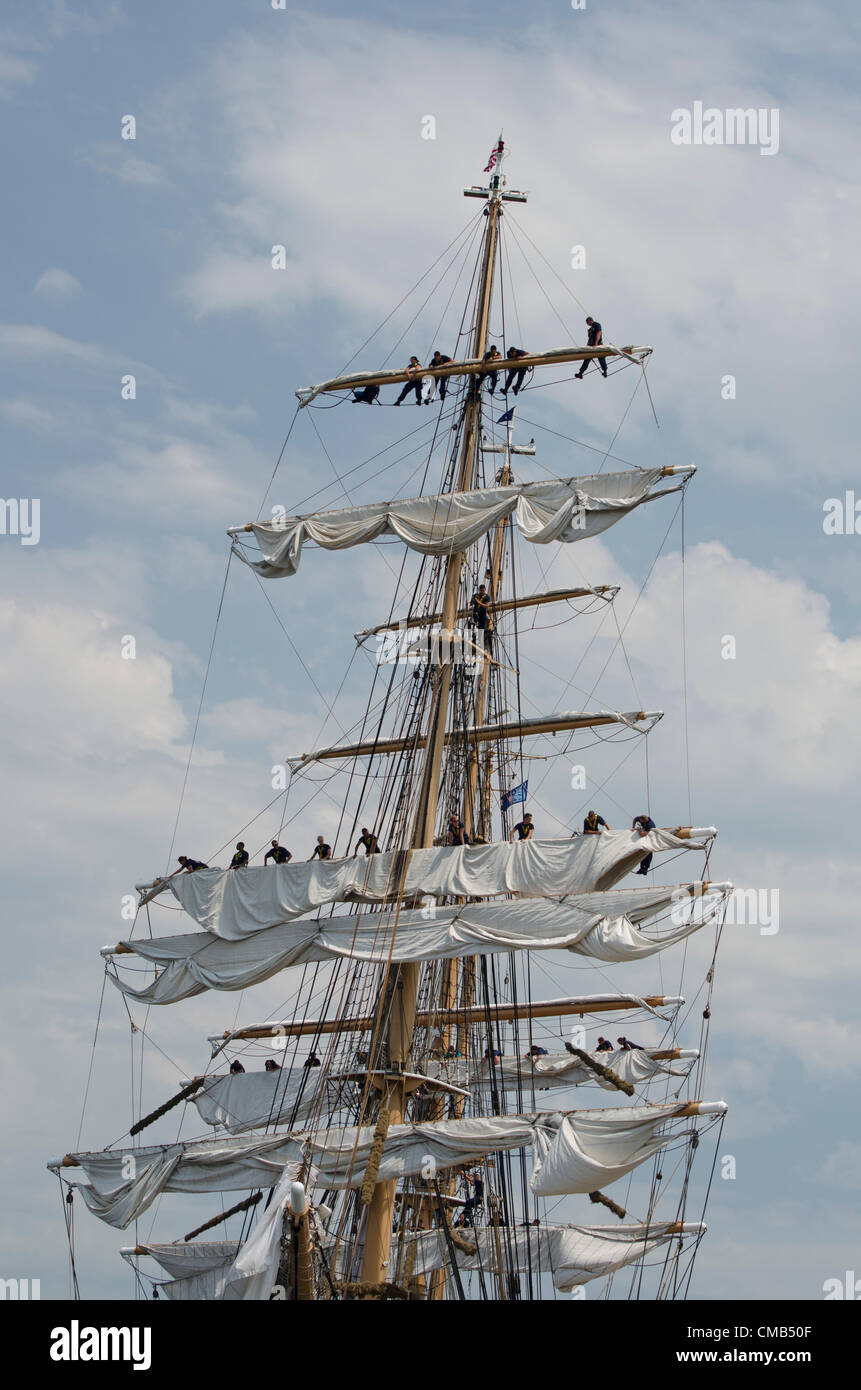Clearly there wasn’t enough time. I don’t know if they were trying or not. I don’t know if the sails were furled or not. In a post above:
Yes, it could be my bad - my knowledge of sailing ships is limited. Furled or unfurled, the sails weren’t set up to catch the wind by the time impact occurred.
Here’s the best picture I could find.

On the topmost yard (where the crew are on the footropes) the sail is furled. The crew gathers it up, lifts it up on top of the yard, then wraps a rope around it to hold it in place.
Remove that rope and the sail drops down from the yard a bit. (Second from the top in the picture.) Its unfurled but not set. That’s the state of the sails in the video of the Cuauhtemoc.
To finish setting the sails, the crew would come down from the rigging and haul on ropes called “sheets”. Those pull the bottom corners of the sail down until it’s taut.
So, either the crew of the Cuauhtemoc were halfway through the process of setting the sails to regain some control, or something else. I strongly suspect the something else.
My first thought was “Mexico has a Navy?” Of course they do. But, huh.
Manning the yards, a ceremonial thing to do when leaving port or rendering honors. With the loss of sailing ships it has evolved to manning the rail.
That was mentioned as a possibility upthread. Sounds likely, but I still have questions. Is it done when leaving port as well as arriving, how soon after unmooring do the crew climb into the rigging, and are the sails usually unfurled when they do it?
Admiral Chatfield says in his memoirs that at one time the Royal Navy wanted to reintroduce sail training, but he nixed it as the Navy no longer had the reservoir of institutional expertise to do it safely.
I don’t understand the point of a modern navy commissioning and operating a sailing ship . I mean, I can see the appeal to tradition, but what utility does it have for a navy?
It is more about team building, leadership training and tradition than anything else. No strategic value if that is what you’re asking, but some value in engaging with the public.
In theory, the sailors learn more about the seas on a sailing ship than a modern warship. Not sure how to assign a value to that.
I’m not sure how many countries do this. The U.S. Coast Guard has USCGC Eagle which was built by Nazi Germany and seized after the war.
We also have the USS Constitution that goes out several times a year of late.
THE 2025 SCHEDULE:
May 16 – USS Constitution Crew Training
June 6 – Honoring D-Day and the United States Marine Corps
July 4 – Independence Day and Public Lottery*
August 22 – Chief Petty Officer Heritage Week #1
August 29 – Chief Petty Officer Heritage Week #2
September 20 – Honoring Purple Heart Recipients
October 21 – Commemorating USS Constitution’s Birthday
I could never see the point in that. If its got an engine and screw, fitted anachronisticly, why are you bothering? Why not build a lookalike and call it Constitution II?
Canada famously has the Bluenose II, but it’s not associated with anything military. It was financed by a brewery and then gifted to the Government of Nova Scotia. The original Bluenose is pictured on the Canadian dime. It was a fishing and racing vessel and was wrecked off the coast of Haiti in 1946.
Fighter jets would never fly inches apart in combat to prevent one hit taking out multiple planes, yet that’s exactly what the Blue Angels, Snowbirds, & a bunch of other military demo teams do. Think of them as a PR / goodwill ambassador/recruitment agent group
I’m pretty sure there’s no engine on the USS Constitution. I’ve never seen her go out, but I’ve always assumed a tugboat brought her out of her mooring.
For that matter, someone told me they don’t set the sails when she goes out to the Harbor. That may be out of date, though; I met someone who was helping repair the rigging a few years ago.
Years ago, she only went out via tugboat, my understanding it they sail the USS Constitution but under the watchful eye of boats that can quickly help out and tow her back.
I think I visited around 2008 or so and the rehab was just finishing up at that point.
At that time there was no motor and I believe that is still true.
Yep, and it may warrant a nuclear response. ![]()
That’s good to hear; I’d love to see it under sail sometime. I wonder how much of the caution is due to concern for the ship, or for the crew. As someone alluded to up thread, this isn’t something they get very much practice at. It takes some skill to do it right.
I think the sailors get some training on the Eagle which sails more regularly.
Non square rigged sailboats aren’t too complicated except under strong winds or in rivers and straits with strong tides. I don’t know about the difficulty of the big square rigs, it seems like a lot more.
Quite a lot, judging by the list on this page: